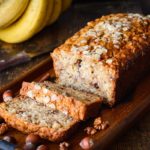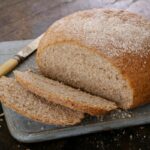Baking bread is very simple and is an easy way for anyone to create a delicious treat that can be served as a meal unto itself or even be served alongside a bunch of other meals as a perfect side dish.
There are so many unique and different ways to bake bread and so many unique recipes. As such, it can be easy to get lost in the minutiae and find yourself following recipes incorrectly!
In such situations, you may be met with bread that is unsatisfying in appearance, taste, and texture.
You may even end up with bread that appears gray in color! And you definitely don’t want to serve gray bread when your friends are expecting tasty and fresh homemade bread.
But what could possibly cause bread to appear gray in color? Is it down to how you store dough? Or even a result of too much air in the mix? Have you accidentally baked gray bread, and now you want to know why it has happened?
Then you have come to the right place! Today, we are going to take a look at a few of the potential reasons for gray bread, so that you can help to make your bread perfect in the future!
Why Is My Bread Gray In Color?
There might actually be a number of reasons why your bread appears to be gray in color after baking. Let’s take a look at these individual reasons for gray bread and gray dough now!
Problems With Ingredients
One of the most common reasons why baking projects go awry is because there is some kind of problem with the ingredients that have been used to create the dough while bread making, which can cause the bread to not rise properly, or result in a dough that just doesn’t bake properly.
Of course, this means that the resulting final bread turns a gray color and perhaps takes on an unpleasant and leathery texture, as the dough may not be right, due to not having enough flour or perhaps having too much flour.
An ingredient that often causes trouble for baking projects once it goes bad is flour.
Many of us have a large supply of flour ready and waiting for use in our kitchens for when we want to start making bread or making dough, but many of us also forget that, though flour has a very long shelf life, it can still easily go bad if not stored correctly.
White flour can turn gray slightly if past its best, and this naturally results in gray loaves of bread beneath even a golden brown crust.
If you were to use flour that had gone bad in a bread recipe, then you may find that the bread ends up not only appearing slightly gray and pale in color but also that the texture of the bread becomes very unsatisfying and incorrect.
This can also happen if the yeast is bad, or if the oven creates too high temperatures that bake bread incorrectly. Your bread dough should preferably make the resulting bread brown.
If other ingredients, such as salt have expired, or are not perfectly suited to bread, then you may find that the bread becomes the incorrect color.
In fact, some frequent bakers have found that specific types of salt can have a direct impact on the color of the bread that the recipe results in.
Try your best to use salt that has less iodine, as salt with more iodine in it can cause the gray color that you want to avoid when baking.
Mold
Of course, one thing that can easily change the texture and look of a loaf of bread is mold.
If you were to bake a loaf of bread and then leave it out, unwrapped or uncovered on your kitchen counter, then it would very quickly become vulnerable to bacteria, and thus begin to develop mold.
Generally, after baking a fresh loaf of bread, you will want to try and keep it in a dry environment kept enclosed away from potential contaminants.
You should try to keep it in an airtight container of some sort, which helps to prevent any bacteria or external moisture from finding its way to the bread.
As well as this, you should also try to consume any bread you bake as quickly as you can. Fresh bread, unlike bread bought at a grocery store, has fewer preservatives in it, which means it will not remain fresh for quite as long.
Don’t forget that it is also possible for bread dough to go moldy if kept improperly, and moldy dough can sometimes be difficult to notice until the bread has been fully baked in the oven and turned gray.
Some bakers may choose to create their bread dough one day, and then leave it for a few days before baking, which can be useful if you need bread made for specific occasions.
However, it is essential to make sure that you keep that dough stored properly before baking so that it does not develop any mold or become spoiled in some way.
This is doubly important considering how much more vulnerable to mold dough is. Dough is naturally higher in water content, thus making it a potential breeding ground for bacteria.
Your bread recipe may just need more flour to make the dough just right.

Your Bread Is Too Moist
At this point, it is easy to say with certainty that too much moisture is one of the biggest culprits in bread going gray in color, so, for your next batch, you should make sure to control the amount of oil, salt, or water mixed into the dough.
The reason why moisture can cause visual problems with bread is not only a result of vulnerability to mold but also because moisture can cause changes to the starch that can be found in bread.
If your bread is too moist, it may appear totally finer after baking, but after spending some time in your fridge, or in a container, it may suddenly become rather gray, or even take on an odd flavor or just taste otherwise totally wrong.
Don’t worry, in such a situation, the bread is still totally safe to eat, it just might be a little bit unsatisfying, as the finished product will not bake properly, and will then take on a totally wrong flavor.
Not only will the bread not look right, creating a subconscious disappointment, but the bread might also be very different in terms of texture!
In order to avoid creating bread that is too moist, you should try your best to follow any bread recipe as closely as you can, to avoid having too much moisture, and to ensure that it comes out perfectly every time.
The bread is less likely to turn gray if you have the right ratios of salt, flour, and oil in the dough.
To Wrap Up
We hope that this guide has proven useful and that you now feel equipped to deal with any future problems that could arise from incorrect ingredient ratios and improper management and storage of ingredients and dough.
Your next load should look just right and avoid the grey coloration provided you bake it just right, and follow the recipe as close as you can, getting the right ratios of things like yeast, oil, salt, and flour. If your dough seems too moist while mixing, try adding some more flour.
Also, keep in mind that freshly baked bread is more vulnerable to mold than local grocery store bread which may be packed with preservatives to make the dough rise and to make the bread go golden brown when baking bread.
Frequently Asked Questions
How Can You Tell If Bread Is Moldy?
It is easy to tell if bread is moldy by taking a look at it. Look around for discolored patches, or any patches of fuzzy stuff appearing on the surface of the bread.
The bread might also smell foul and even sour. If you taste it and the bread tastes strange or is hard, then do not eat it anymore.
To avoid mold developing on bread, make sure that it is stored at the right temperature and you keep it in the right way, such as in smaller containers, or even in the fridge to keep the temperature right.
What Color Is Bread Mold?
The mold that appears on breads can actually be any color at all, but most commonly, the mold will be green in color. It all depends on the type of fungus that is growing on the bread.
Some mold may have a dark color, while some may make the bread turn gray.
Some bread may take up to two weeks to begin to spoil, but generally, you need to make sure that you consume your bread as quickly as possible to maintain the best flavor and to avoid it being exposed to a bad temperature.
We also recommend wrapping the bread up in plastic wrap to further protect it from the elements.
Is Bread Mold Toxic?
The mold that can grow on bread should not cause you too much harm provided you do not intentionally consume too much of it. If you accidentally ingest some, don’t panic, as the mold that develops on old dough or old bread is not too harmful.










